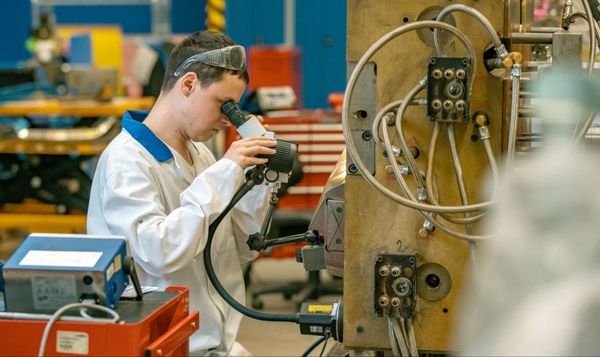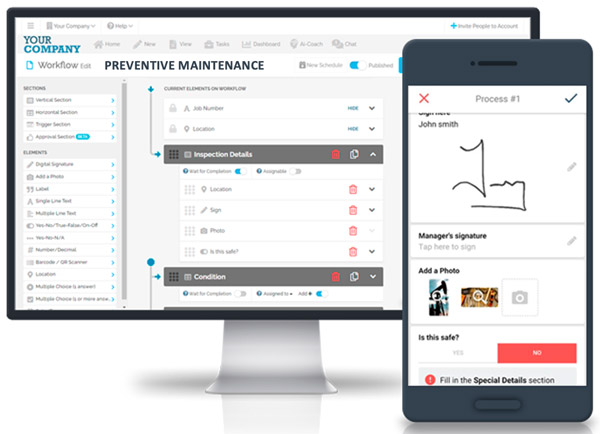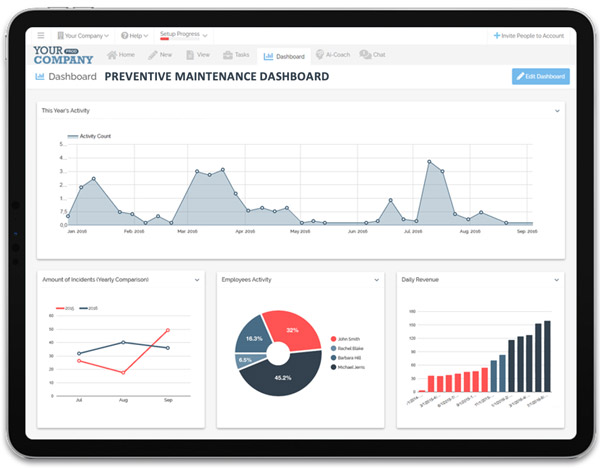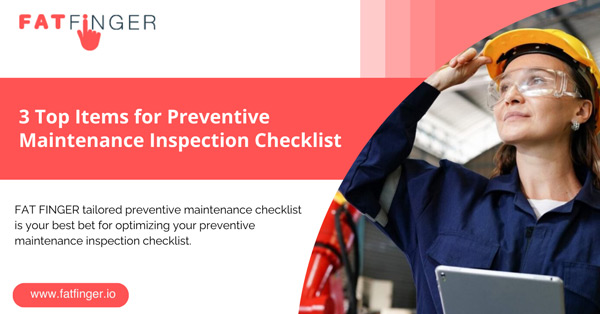Preventive maintenance can save your manufacturing facility from collapsing.
Take The Deepwater Horizon story for example.
In 2010, they experienced a major disaster. The drilling rig exploded and caused a massive oil spill that lasted for 87 days.
Following investigations, the U.S. government revealed that the accident was a result of a surge of natural gas blasting through a recently installed concrete core.
Effective preventive maintenance inspections would have identified the weak concrete core before it became a disaster.
At FAT FINGER, we acknowledge the importance of preventive maintenance inspection. That’s why we recommend using our no-code mobile application builder to develop preventive maintenance inspection checklists.
An effective preventive maintenance inspection checklist must ensure it covers all the items in a manufacturing facility that perform the following functions:
- Regulate temperature, humidity, and air quality
- Provide power
- Supply and drain water
1 – The HVAC System

The heating, ventilation, and air conditioning (HVAC) system helps regulate temperature, humidity, and air quality within a manufacturing facility. All these aspects affect the quality of products being produced and the health and productivity of employees.
It does this by circulating filtered air through its ducts and cooling it to absorb heat within the facility.
When manufacturing facilities are located in harsh climate areas, the natural environmental conditions are not suitable for operational excellence.
As if that’s not enough, the products and equipment used could be sensitive to unfavorable temperature and humidity levels, causing them to reduce in quality.
This is why you should conduct regular inspections of the HVAC system to ensure that its components are able to filter air, pass it through its vents, absorb heat, and dissipate the heat outdoors.
The following parts of an HVAC system should always be inspected during the inspection:
- Air filters. These help maintain good indoor air quality by preventing dust, dirt, and other airborne particles from circulating through the manufacturing facility.
Dirty air filters can lead to reduced airflow, decreased system efficiency, and a higher energy cost.
- Air ducts. These are the pathways that deliver conditioned air to different parts of the facility. During preventive maintenance, technicians should inspect and clean the air ducts to ensure they are free from debris and are properly insulated.
This improves air quality and system efficiency and reduces energy costs.
- Condenser coils. These are responsible for releasing the heat absorbed by the refrigerant into the outdoor air. A dirty condenser can lead to premature system failure.
Therefore, technicians should clean the condenser coils during preventive maintenance to ensure longevity.
- Refrigerant levels. This is the substance that circulates through the HVAC system, absorbing and releasing heat to regulate the indoor temperature. Low refrigerant levels can lead to system damage.
As a result, technicians should always maintain the refrigerant levels at their peak efficiency.
- Thermostat. This part is responsible for measuring the temperature and sending signals to the rest of the system to either increase, decrease or maintain the current temperature.
Basically, it serves as the control center for the HVAC system. So, the maintenance technicians should always ensure that it has no faults.
All these parts should be checked for any leaks, damage, or wear and tear that could affect their efficiency.
Regular inspections of your HVAC system can save you a lot of money by preventing costly repairs or replacements. Additionally, well-maintained HVAC systems are energy efficient, reducing your property’s energy bills.
2 – The Electrical System
This system provides the power needed to run a whole manufacturing facility. Without it, the facility shuts down.
That’s why it is a must-have item in your preventive maintenance inspection checklist.
Electrical equipment and machinery are often susceptible to wear and tear, which can lead to malfunctions or even accidents.
Did You Know? Although accidents and near misses at manufacturing facilities may seem similar, there are notable differences. Our previous article covers these differences in more depth.
Regular inspections of electrical equipment can prevent unexpected failures and ensure the safety of workers and equipment.
When inspecting the electrical system in a manufacturing facility, make sure to check for the following:
- Loose connections. These can lead to excessive heat, fire, and other hazards, leading to equipment downtime and loss of productivity.
During preventive maintenance, technicians should inspect and tighten all electrical connections to ensure they are secure and avoid potential hazards.
- Damaged insulation. This creates a risk of electric shock or fires.
Technicians should inspect all electrical wiring components for signs of damage or wear, and replace any insulation that is no longer effective.
- Overheating. Electrical items such as motors and circuit breakers generate heat during operation.
Excessive heat can damage the components and create fire hazards. It is mostly caused by either electrical overloading, poor ventilation, or aging components.
Technicians should check for signs of overheating such as burnt or discolored insulation, unusual smells, or hot spots on equipment, and take corrective action.
Inspecting electrical systems can also improve efficiency. Properly functioning electrical equipment reduces downtime, increases productivity, and saves on energy costs.
By identifying any issues early, you can address them promptly, reducing the likelihood of unexpected shutdowns or inefficiencies.
3 – The Plumbing System

This system’s main role is to bring clean water into the manufacturing facility, and draw dirty water out.
It is a simple but very crucial role.
A damaged or poorly maintained plumbing system features leaks, flooding, and water damage, leading to water spilling within the facility or dirty water draining in unconventional places.
Therefore, it is essential to include a thorough inspection of the plumbing system in the preventive maintenance checklist.
During the plumbing system inspection, the inspector should check for any visible leaks or signs of corrosion in the pipes, fixtures, and fittings.
On top of that, they should check the water pressure to ensure it is sufficient for the building’s needs. Insufficient water pressure may be a result of blockages within the plumbing system. This is solved by simply identifying the clog and removing it.
Now, this is important; a plumbing system inspection can often detect issues that are not apparent. For instance, using thermal cameras to identify hidden leaks or digital tools to monitor water usage can reveal potential problems before they cause significant destruction.
Bonus Tip: Consider installing pressure-regulating valves to maintain consistent water pressure throughout the building. This helps prevent damage to pipes and ensures efficient water usage.
A detailed plumbing system inspection is vital to preventing costly water damage and maintaining the building’s functionality.
Effective Preventive Maintenance Inspection Practices

The electric, HVAC, and plumbing systems are a must-have item on your preventive maintenance inspection checklist but not the only ones in a manufacturing facility.
Implementing effective preventive maintenance inspection practices will ensure that your customized inspection checklist covers all aspects of your maintenance facility.
Since preventive maintenance uses a proactive approach to identify and address potential issues before they become problems, your inspection practices should include a series of proactive actions that identify and address issues in your manufacturing facilities.
Fortunately, FAT FINGER can help you implement such actions.
We provide a no-code builder that can build enterprise-grade mobile applications capable of doing the following:
- Implementing maintenance management software. Maintenance management software will significantly reduce downtime, delivery delays, and long-term costs associated with manual maintenance processes. It automates all the preventive maintenance tasks across asset life cycles.
FAT FINGER is an example of such software. Our no-code builder uses machine learning to enable frontline workers to build enterprise-grade mobile applications that implement their maintenance checklists.
- Implementing performance monitoring devices. Installing performance monitoring devices on running machines provides priceless business insights.
Data collected by these devices, either in real-time or at specific intervals, can be collated into a centralized management system like FAT FINGER. This way, managers can have a comprehensive view of their business operations, increasing their efficiency in preventive maintenance.
- Training and development. As your manufacturing facility grows, continuous training guarantees that all staff members and executive leaders are up to date with the facility’s maintenance procedures.
- Maximizing machine learning protocols. If your manufacturing facility has limited resources, it can benefit immensely from regularly monitoring and maintaining your equipment according to previous maintenance intervals.
Frontline workers can use FAT FINGER’s machine learning to determine when and how to employ maintenance efforts. This way, they do not have to keep worrying about the items they need to include or exclude.
Ultimately, FAT FINGER’s tailored preventive maintenance checklist is your best bet for optimizing your preventive maintenance inspection checklist.
Optimize Your Preventive Maintenance Inspections Using FAT FINGER

Manual inspections are time-consuming and always have a risk of human error.
This is why we recommend integrating FAT FINGER’s machine learning digital procedures into your preventive maintenance inspections.
Our enterprise-grade mobile applications allow frontline workers to drag-and-drop inspection routines based on real-time data from the facility and enhance their workflows.
Incorporating digital solutions like FAT FINGER can significantly improve the process of preventive maintenance inspections.
This table shows how much of an improvement digital preventive maintenance management would be over traditional preventive maintenance management.
| Comparison Factor | Traditional Preventive Maintenance Management | Digital Preventive Maintenance Management |
| Inspection Accuracy | Relies on manual input and checking, prone to errors | Automated system improves accuracy and reduces errors |
| Cost of Inspection | Expensive due to manual labor and downtime required | Less expensive due to streamlined processes and reduced downtime |
| Maintenance Planning | Reactive maintenance planning, based on failure events | Proactive maintenance planning based on real-time data and analytics |
| Data Management | Manual record-keeping with risk of data loss or misplacement | Digital record-keeping with centralized data management, accessible from anywhere |
By using digital solutions, property managers can easily access and update inspection checklists, track inspection results, and receive real-time alerts for any potential issues.
This not only saves time and improves accuracy but also helps property managers detect potential problems early, minimizing downtime and repair costs.
To put it briefly, conducting preventive maintenance inspection through mobile asset inspection is more efficient than doing it manually.
Here’s how to do it yourself.
This video shows how to use FAT FINGER to schedule inspections, optimizing your preventive maintenance inspections.
Incorporate Preventive Maintenance Inspections in your Manufacturing Facility
Ultimately, preventive maintenance inspections are crucial for property management. By establishing a checklist and following it regularly, property managers can avoid costly repairs and ensure the safety and comfort of their occupants.
The HVAC system, electrical system, and plumbing system are must-have items on every manufacturing facility’s checklist.
Incorporating these items into the checklist is a reliable way to ensure the smooth operation of properties.
Action: Manage your maintenance program on the move by signing up for a free trial of FAT FINGER’s preventive maintenance workflow.
These inspections not only prevent potential problems but also optimize operational excellence.
“We have seen a significant reduction in downtime, delivery delays, and long-term costs associated with manual maintenance processes.We’re incredibly pleased with the results we’ve seen since incorporating FAT FINGER.” – Jay Williams, Reliability Engineer
Share on LinkedIn



